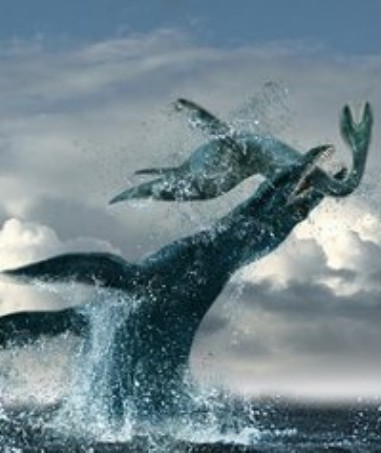
October 7, 2006
Scientists have found a fossil of a monster fish-like reptile in a 150 million-year-old Jurassic graveyard on an Arctic island off Norway.
The Norwegian researchers discovered remains of a total of 28 plesiosaurs and ichthyosaurs at a site on the island of Spitsbergen, about 1300 kilometres from the North Pole.
At the time these were the top marine predators, when dinosaurs dominated on land.
"One of them was this gigantic monster, with vertebrae the size of dinner plates and teeth the size of cucumbers," says Dr Joern Hurum, an assistant professor at the University of Oslo.

The bus-sized monster catching a smaller plesiosaur (Image: Natural History Museum, University of Oslo, Norway/Tor Sponga, BT)
"We believe the skeleton is intact and that it’s about 10 metres long," he says of the pliosaur, a type of plesiosaur with a short neck and massive skull. The team dubbed the specimen The Monster.
Such pliosaurs are known from remains in countries including the UK and Argentina but no complete skeleton has been found, Hurum says.
The skull of the pliosaur, perhaps a distant relative to Scotland’s mythical Loch Ness monster, is among the biggest on record.
Scientists will return next year to try to excavate the entire fossil, buried on a hillside.
Plesiosaurs, which swam with two sets of flippers, often preyed on smaller dolphin-like ichthyosaurs. All went extinct when the dinosaurs vanished 65 million years ago.
The scientists rate the fossil graveyard "one of the most important new sites for marine reptiles to have been discovered in the last several decades".
"It is rare to find so many fossils in the same place. Carcasses are food for other animals and usually get torn apart," Hurum says.
He thinks the reptiles did not die at the same time in some Jurassic-era cataclysm but died over thousands of years in the same area.
They then become preserved in what was apparently a deep layer of black mud on the seabed.
At that time, the area of Spitsbergen was under water several hundred kilometres further south, around the latitude of Anchorage or Oslo.
Hurum says the presence of fossils is also an interesting pointer for geologists hunting for oil and gas deposits in the Barents Sea to the east.
"A skull we found even smells of petrol," he says.
Source: ABC (Australian Broadcasting Corporation) Science Online
About Craig Woolheater
Co-founder of Cryptomundo in 2005.
I have appeared in or contributed to the following TV programs, documentaries and films:
OLN's Mysterious Encounters: "Caddo Critter", Southern Fried Bigfoot, Travel Channel's Weird Travels: "Bigfoot", History Channel's MonsterQuest: "Swamp Stalker", The Wild Man of the Navidad, Destination America's Monsters and Mysteries in America: Texas Terror - Lake Worth Monster, Animal Planet's Finding Bigfoot: Return to Boggy Creek and Beast of the Bayou.
Filed under Bigfoot Report, Cryptozoology, Evidence, Expedition Reports, Extinct, Lake Monsters, Living Dinosaurs, Loch Ness Monster, Sea Serpents